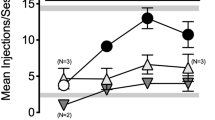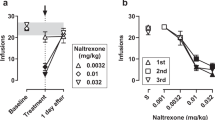Abstract
Rationale
Delta-opioid agonists enhance the antinociceptive efficacy of methadone and other mu-opioid agonists. However, relatively little is known about the degree to which delta agonists might enhance the abuse-related effects of mu agonists.
Objective
This study used a behavioral economic approach to examine effects of the delta agonist SNC80 [(+)-4-[(αR)-α-((2S,5R)-4-allyl-2,5-dimethyl-1-piperazinyl)-3-methoxybenzyl]-N,N-diethylbenzamide] on the reinforcing effects of methadone in a drug self-administration assay. Interactions between SNC80 and cocaine were also examined for comparison.
Methods
Rhesus monkeys (n = 4), surgically implanted with indwelling intravenous catheters, were tested in two phases. In phase 1, drug self-administration dose-effect curves for methadone (0.0032–0.1 mg/kg/injection (inj)) and cocaine (0.0032–0.32 mg/kg/inj) alone were determined under a fixed-ratio 10 (FR 10) schedule of reinforcement. In phase 2, FR values were increased every 3 days (FR 1–FR 1800) during availability of methadone alone (0.032 mg/kg/inj) and in combination with varying proportions of SNC80 (0.1:1, 0.3:1, and 0.9:1 SNC80/methadone) or of cocaine alone (0.032 mg/kg/inj) and in combination with varying proportions of SNC80 (0.33:1, 1:1, and 3:1 SNC80/cocaine). Demand curves related drug intake to FR price, and measures of reinforcement were derived.
Results
Methadone and cocaine alone each functioned as a reinforcer. SNC80 did not alter measures of reinforcement for either methadone or cocaine.
Conclusions
SNC80 at proportions previously shown to enhance methadone-induced antinociception did not enhance the abuse-related effects of methadone. These results support the proposition that delta agonists may selectively enhance mu agonist analgesic effects without enhancing mu agonist abuse liability.



Similar content being viewed by others
References
Adams JU, Tallarida RJ, Geller EB, Adler MW (1993) Isobolographic superadditivity between delta and mu opioid agonists in the rat depends on the ratio of compounds, the mu agonist and the analgesic assay used. J Pharmacol Exp Ther 266:1261–1267
Banks ML, Gould RW, Czoty PW, Nader MA (2008) Relationship between response rates and measures of reinforcing strength using a choice procedure in monkeys. Behav Pharmacol 19:365–369
Banks ML, Folk JE, Rice KC, Negus SS (2010) Selective enhancement of fentanyl-induced antinociception by the delta agonist SNC162 but not by ketamine in rhesus monkeys: further evidence supportive of delta agonists as candidate adjuncts to mu opioid analgesics. Pharmacol Biochem Behav 97:205–212
Danielsson I, Gasior M, Stevenson GW, Folk JE, Rice KC, Negus SS (2006) Electroencephalographic effects of the delta opioid agonist SNC80 in rhesus monkeys. Pharmacol Biochem Behav 85:428–434
Dietis N, Guerrini R, Calo G, Salvadori S, Rowbotham DJ, Lambert DG (2009) Simultaneous targeting of multiple opioid receptors: a strategy to improve side-effect profile. Br J Anaesth 103:38–49
Dykstra L, Granger A, Allen R, Zhang X, Rice K (2002) Antinociceptive effects of the selective delta opioid agonist SNC80 alone and in combination with mu opioids in the squirrel monkey titration procedure. Psychopharmacology 163:420–429
Griffiths RR, Wurster RM, Brady JV (1975) Discrete-trial choice procedure: effects of naloxone and methadone on choice between food and heroin. Pharmacol Rev 27:357–365
Heyman JS, Jiang Q, Rothman RB, Mosberg HI, Porreca F (1989) Modulation of mu-mediated antinociception by delta agonists: characterization with antagonists. Eur J Pharmacol 169:43–52
Hursh SR (1991) Behavioral economics of drug self-administration and drug abuse policy. J Exp Anal Behav 56:377–393
Hursh SR, Silberberg A (2008) Economic demand and essential value. Psychol Rev 115:186–198
Hursh SR, Winger G (1995) Normalized demand for drugs and other reinforcers. J Exp Anal Behav 64:373–384
Jutkiewicz EM, Baladi MG, Folk JE, Rice KC, Woods JH (2008) The δ-opioid receptor agonist SNC80 (+)-4-[Œ ± (R)-Œ± − [(2 S, 5R)-4-allyl-2, 5-dimethyl-1-piperazinyl]-(3-methoxybenzyl)-N, N-diethylbenzamide] synergistically enhances the locomotor-activating effects of some psychomotor stimulants, but not direct dopamine agonists, in rats. J Pharmacol Exp Ther 324:714–724
Ko MC, Terner J, Hursh S, Woods JH, Winger G (2002) Relative reinforcing effects of three opioids with different durations of action. J Pharmacol Exp Ther 301:698–704
Leppert W (2009) The role of methadone in cancer pain treatment—a review. Int J Clin Pract 63:1095–1109
Linderbeck LR (2008) Update of the clinical issues regarding methadone (Dolophine) therapy in pain management. AACN Adv Crit Care 19:253–257
Matsuzaki M (1978) Alteration in pattern of EEG activities and convulsant effect cocaine following chronic administration in the rhesus monkey. Electroencephalogr Clin Neurophysiol 45:1–15
Negus SS (2003) Rapid assessment of choice between cocaine and food in rhesus monkeys: effects of environmental manipulations and treatment with D-amphetamine and flupenthixol. Neuropsychopharmacology 28:919–931
Negus SS (2004) Delta opioids and substance abuse. In: Chang KJ, Porreca F, Woods JH (eds) The delta receptor. Marcel Dekker, New York, pp 401–431
Negus SS (2006) Choice between heroin and food in nondependent and heroin-dependent rhesus monkeys: effects of naloxone, buprenorphine, and methadone. J Pharmacol Exp Ther 317:711–723
Negus SS, Rice KC (2009) Mechanisms of withdrawal-associated increases in heroin self-administration: pharmacologic modulation of heroin vs. food choice in heroin-dependent rhesus monkeys. Neuropsychopharmacology 34:899–911
Negus SS, Butelman E, Chang K, DeCosta B, Winger G, Woods J (1994) Behavioral effects of the systemically active delta opioid agonist BW373U86 in rhesus monkeys. J Pharmacol Exp Ther 270:1025–1034
Negus SS, Gatch MB, Mello NK, Zhang X, Rice K (1998) Behavioral effects of the delta-selective opioid agonist SNC80 and related compounds in rhesus monkeys. J Pharmacol Exp Ther 286:362–375
Negus SS, Schrode K, Stevenson GW (2008) Mu/kappa opioid interactions in rhesus monkeys: implications for analgesia and abuse liability. Exp Clin Psychopharmacol 16:386–399
Negus SS, Bear AE, Folk JE, Rice KC (2009) Role of delta opioid efficacy as a determinant of mu/delta opioid interactions in rhesus monkeys. Eur J Pharmacol 602:92–100
O'Neill SJ, Collins MA, Pettit HO, McNutt RW, Chang KJ (1997) Antagonistic modulation between the delta opioid agonist BW373U86 and the mu opioid agonist fentanyl in mice. J Pharmacol Exp Ther 282:271–277
Sheldon RJ, Nunan L, Porreca F (1989) Differential modulation by [d-Pen2, d-Pen5]enkephalin and dynorphin A-(1–17) of the inhibitory bladder motility effects of selected mu agonists in vivo. J Pharmacol Exp Ther 249:462–469
Stevenson GW, Folk JE, Linsenmayer DC, Rice KC, Negus SS (2003) Opioid interactions in rhesus monkeys: Effects of δ + μ and δ + κ agonists on schedule-controlled responding and thermal nociception. J Pharmacol Exp Ther 307:1054–1064
Stevenson GW, Folk JE, Rice KC, Negus SS (2005) Interactions between delta and mu opioid agonists in assays of schedule-controlled responding, thermal nociception, drug self-administration, and drug versus food choice in rhesus monkeys: studies with SNC80 [(+)-4-[(alpha ± R)-alpha-((2 S,5R)-4-Allyl-2,5-dimethyl-1-piperazinyl)-3-methoxybenzyl]-N,N-diethylbenzamide] and heroin. J. J Pharmacol Exp Ther 314:221–231
Su YF, McNutt RW, Chang KJ (1998) Delta-opioid ligands reverse alfentanil-induced respiratory depression but not antinociception. J Pharmacol Exp Ther 287:815–823
Wade-Galuska T, Winger G, Woods J (2007) A behavioral economic analysis of cocaine and remifentanil self-administration in rhesus monkeys. Psychopharmacology 194:563–572
Winger G, Hursh SR, Casey KL, Woods JH (2002) Relative reinforcing strength of three N-methyl-D-aspartate antagonists with different onsets of action. J Pharmacol Exp Ther 301:690–697
Winger G, Galuska CM, Hursh SR, Woods JH (2006) Relative reinforcing effects of cocaine, remifentanil, and their combination in rhesus monkeys. J Pharmacol Exp Ther 318:223–229
Woolverton WL, Johanson CE (1984) Preference in rhesus monkeys given a choice between cocaine and d, l-cathinone. J Exp Anal Behav 41:35–43
Woolverton WL, Nader MA (1990) Experimental evaluation of the reinforcing effects of drugs. In: Adler MW, Cowans A (eds) Modern methods in pharmacology: testing and evaluation of drugs of abuse. Wiley-Liss, Inc., New York, pp 165–192
Acknowledgments
We appreciate the technical assistance of Jennifer Gough. This research was supported by National Institutes of Health grants R01-DA011460 and T32-DA007027.
Author information
Authors and Affiliations
Corresponding author
Rights and permissions
About this article
Cite this article
Banks, M.L., Roma, P.G., Folk, J.E. et al. Effects of the delta-opioid agonist SNC80 on the abuse liability of methadone in rhesus monkeys: a behavioral economic analysis. Psychopharmacology 216, 431–439 (2011). https://doi.org/10.1007/s00213-011-2235-2
Received:
Accepted:
Published:
Issue Date:
DOI: https://doi.org/10.1007/s00213-011-2235-2




